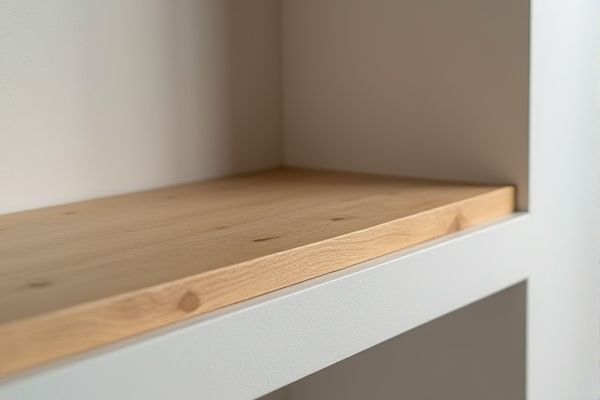
Mitered shelf edges offer a sleek, seamless look by joining two pieces at a 45-degree angle, enhancing the visual flow of your shelves, while square shelf edges provide a classic, sturdy appearance with clean, straight lines that are easier to fabricate and maintain. Explore the rest of the article to determine which edge style best complements your design preferences and functional needs.
Table of Comparison
| Feature | Mitered Shelf Edge | Square Shelf Edge |
|---|---|---|
| Design | Angled 45-degree cut edges creating a seamless corner | Straight 90-degree cut edges with a flat corner |
| Appearance | Elegant, modern, smooth edge lines | Simple, traditional, robust look |
| Construction | Requires precise cutting and gluing for tight joints | Easier to manufacture, minimal finishing needed |
| Durability | Susceptible to damage if joint weak; needs quality craftsmanship | More durable with less chance of edge damage |
| Cost | Higher due to complexity and labor | Lower; cost-effective for most projects |
| Applications | High-end cabinetry, designer furniture | Standard shelving, utility furniture |
Introduction to Shelf Edge Designs
Mitered shelf edges create a seamless, angled joint that enhances the aesthetic appeal by providing a smooth, continuous line, ideal for modern and elegant interiors. Square shelf edges offer a simple, clean, and more traditional look, featuring a right-angled corner that is easier to manufacture and maintain. Your choice between mitered and square shelf edges impacts both the visual style and the durability of the shelving unit.
What is a Mitered Shelf Edge?
A mitered shelf edge features a beveled joint where two edges meet at a 45-degree angle, creating a seamless, clean corner that enhances both the aesthetic appeal and structural integrity of the shelf. This design minimizes visible end grain and gives your furniture a more polished, high-end appearance compared to a traditional square shelf edge. Choosing a mitered edge not only elevates the visual sophistication but also improves durability by distributing weight and stress more evenly along the joint.
What is a Square Shelf Edge?
A square shelf edge features a clean, 90-degree angle with sharp corners, providing a straightforward and modern look. This edge style is simple to fabricate and offers durability without added complexity, making it a popular choice for functional shelving. Your selection between mitered and square edges should consider both design preferences and the desired visual impact.
Key Differences Between Mitered and Square Shelf Edges
Mitered shelf edges feature angled cuts that create a seamless, continuous look by joining two pieces at a 45-degree angle, enhancing the aesthetic appeal and providing a smoother finish. Square shelf edges have straight, 90-degree cuts that result in a more traditional, sturdy appearance but can appear bulkier and less refined. Your choice between mitered and square edges impacts both the visual style and perceived craftsmanship of shelving installations.
Aesthetic Impact on Interior Design
Mitered shelf edges create a seamless, elegant look by joining two pieces of wood at a precise 45-degree angle, enhancing the visual flow and sophistication of interior design. Square shelf edges provide a clean, sharp appearance that emphasizes modern minimalism and structural clarity, often complementing contemporary or industrial decor styles. The choice between mitered and square edges significantly influences the overall ambiance, with mitered edges offering a softer, refined aesthetic, while square edges contribute to a bold, defined look.
Durability and Strength Comparison
Mitered shelf edges provide a sleek, seamless look but can be less durable due to the glued joint, which may weaken under heavy loads or impact compared to square shelf edges. Square shelf edges feature a continuous grain and solid construction, offering superior strength and resistance to damage over time. Choosing a square edge can enhance the longevity of Your shelves, especially in high-use environments.
Ease of Installation and Construction
Mitered shelf edges require precise cutting at a 45-degree angle, making installation more complex and time-consuming compared to square shelf edges, which involve straightforward 90-degree cuts and simpler assembly. Square edges offer greater ease of construction due to fewer alignment issues and reduced need for specialized tools or advanced carpentry skills. Choosing square edges can significantly streamline the installation process while mitered edges demand higher craftsmanship for a seamless finish.
Cost Considerations for Each Edge Style
Mitered shelf edges typically involve higher labor costs due to precise cutting and joining techniques, increasing overall installation expenses compared to square edges. Square shelf edges are more cost-effective, as they require simpler cuts and less finishing work, reducing material waste and production time. Choosing the right edge style for your project depends on balancing aesthetic preferences with budgetary constraints.
Best Applications for Mitered vs. Square Shelf Edges
Mitered shelf edges offer a seamless, elegant look ideal for high-end cabinetry, display shelves, and modern interior designs where aesthetics and smooth transitions are crucial. Square shelf edges suit functional applications like industrial storage, utility shelves, or areas requiring durability and easy replacement, providing clean, straightforward lines that withstand heavy use. Your choice depends on whether you prioritize decorative appeal or practicality in your shelving project.
How to Choose the Right Shelf Edge for Your Project
Choosing the right shelf edge involves considering both aesthetics and functionality; a mitered edge offers a seamless, elegant look by joining two pieces at a 45-degree angle, ideal for showcasing wood grain and creating a polished finish. Square edges provide a clean, modern appearance with straightforward construction, better suited for durability and ease of maintenance in high-traffic areas. Your decision should reflect the style of your space, the durability required, and the skill involved in installation.
 homyna.com
homyna.com